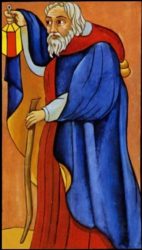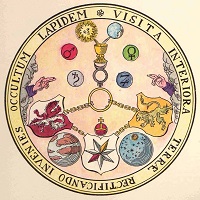For most men life is made up of two days:
- In the first they believe everything.
- And in the second, nothing.
For a few others, life also has two days, but what distinguishes them from ordinary men is that
- In the first day they believe only in illusions, and these are nothing;
- While in the second day, they believe in everything, for they believe in truth, which is all.
~ Louis-Claude de Saint-Martin
Since Rene Guenon was an initiate into a Martinism order, it may be of interest to explore their teachings. Martinism derives its name from the two “Martins”: Martinez Pasquales and Louis-Claude de Saint-Martin. The former mysteriously appeared with an order based on theurgy or ceremonial magic. The latter joined that order, but eventually abandoned it when he felt that he moved beyond “operations”. There was a loose group that gathered around him, the S.I. for the Order of Superieurs Inconnus (Unknown Superiors) and initiation was decidedly less formal.
Now Martinism claims its origin from God which was communicated from Adam to Noah to Melchisedek and then Abraham, Moses, Solomon, and Zerubbabel. In other words, there has always been this hidden tradition. Valentin Tomberg called it the Church of John. In a sense Tomberg completes this teaching, since he claims there is no longer a need for an “order”. Furthermore, the uneasy, and often hostile, relationship between the Johannine and Petrine churches is to be rectified.
Martinist Doctrine
The doctrine hinges on a particular view of the fall of man; these are the fundamental points:
- Original Man (or Primitive Adam or Archetypal Man) was emanated by God and dwelt on a high plane where he enjoyed a privileged position.
- Through the misuse of his free will, Primitive Adam sinned and as a result fell.
- As a result of the Fall, Man, originally a unified being, became shattered into numerous individualities who are now the men and women of the material world.
- Individual man’s task is to reintegrate himself back to the Archetype. All men and women must reintegrate with the Archetype so that Primitive Adam can be reconstituted and unity be again achieved.
The purpose of the order was to provide a way to achieve that task of reintegration.
Gregory of Nyssa on Adam
Lest anyone think that is absurd or even heretical, I refer you to Gregory of Nyssa, as explained by Vladimir Lossky in The Mystical Theology of the Eastern Church:
The person transcends and is free from his nature, i.e., not determined by it. The individual, on the other hand, which is the material manifestation and individuation, is often confused with the person. Thus, it is the individual which must be transcended. The Person is in a formless state. After the Fall, human nature became divided and broken into many individuals. Man has a double character: as an individual nature, he is a part of a whole, but as a person, he is in no sense a part, he contains all in himself.
So in our language the individual is a lower state of being and the person is a higher state. Human nature is disintegrated into multiplicity; in theological terms, human nature lost the “Integrity” which Adam possessed. It is man as individual that is transcended, not man as person. In the latter state, he is in the image of God and able to reach the Divine Union.
Saint-Martin’s Principles
Saint-Martin was attracted to the spiritual and esoteric life from an early age and remained a lifelong Catholic. He tells us the principle he discovered that guided his life:
- Despite all the confusions of philosophy, he had attained certitude as to God and his own soul.
- The seeker for wisdom had need of nothing more.
- The foundation of happiness lies in contentment with the truth.
- Absorption in material things was incomprehensible for those who knew the treasures of reason and the spirit.
- Human science explained matter by matter, but after its putative proofs, there were other demonstrations needed.
- The inmost prayer of his soul was for God to abide therein to the exclusion of all else. Thus Divine Union is the true end of man.
- We are all widowed and are called to a second marriage.
Nothing could be clearer. He starts with knowledge of the self and knowledge of God. He ends with the Divine Union, which he relates to a type of marriage. In brief, we can refer to a couple of high points in his doctrine, specifically as they relate to recent discussions.
The Will and Silencing the Mind
Saint-Martin makes clear that the Divine Union can be accomplished in this life, rather than postmortem. First of all, a man must become aware of himself as a Person. He writes:
When we have once sensed our soul, we are left in no doubt as to its possibility.
The individual whose inner content is filled with opinions, desires, emotions, likes, dislikes, and sensations will experience nothing but doubt. To overcome that, the will must be conformed. He tells us:
Let me affirm that divine union is a work which can be accomplished only by the strong and constant resolution of those who desire it; that there is no other means to this end but the persevering use of a pure will, aided by the works and practice of every virtue, fertilized by prayer, that divine grace may come to help our weakness and lead us to the term of our regeneration.
The Martinist way now makes sense. It is not a question of overcoming human nature, but of transforming the fallen nature into something higher. Without understanding the state of Fallen man, one can only interpret such writings as overcoming human nature itself. That is not so; rather the goal is to transcend the fallen state and rise back to the Primordial State (“reintegration”). Clearly, man in the fallen state cannot accomplish that on his own, but requires an impetus from above him. This is not an indication of passivity, since it is the Will, the very source of activity, that must be employed.
To recap thus far: first, a man becomes aware of the possibilities of his soul, which makes him dissatisfied with ordinary life. Then he purifies the Will, which is no longer interested in ordinary pursuits. However, he still does not know how to proceed without an impetus from above. Unfortunately, the lot of mankind, although steeped in ignorance, is to make stuff up. Saint-Martin writes:
It is a sad vision indeed, that when we start looking at Man, we see him at the same time tormented by the desire to know, failing to find a reason for anything, but daring nevertheless to give a reason to everything.
Hence, man must first admit that he knows nothing, so he can follow his path open to Divine Grace. Otherwise, the knowledge he imagines he possesses will form an insurmountable obstacle to his progress.
The Active Path
Although Saint-Martin uses the word “mysticism”, he technique is more active. First of all, let’s see how he understand mysticism:
The only initiation which I preach and seek with all the ardour of my soul is that by which we may enter into the heart of God and make God’s heart enter into us, there to from an indissoluble marriage …
Once again, there is that alchemical imagery with the idea of “work”. The marriage of the soul with God is both a union and a separation. That is the proper meaning of “non-duality” … not two, but not one either. A marriage is the apt symbol, since it is a union without annihilating either one. For “God” to annihilate the man is a form of monism, not non-dualism.
The Inner Way of Saint-Martin is individual and particular for each person. Concentration and contemplation are actually active, not passive. Try it, and you will see how difficult it is to maintain the focus of the mind. In the book which we shall mention below, his way is compared to Saint John of the Cross, who says that contemplation is infused passively so that illumination is awaited rather than sought. Saint-Martin sought to establish the correspondence of the soul with the Divine by the active path of WORKS. For the path of the Inner Way, we
seek to explain material things by man, and not man by material things.
That certainly deserves more thought than the few seconds required to read it. Who is prepared to understand the entire course of his life and the manifestation of his inner states?
Acknowledgment
For the source of the doctrines and quotations, I relied on the little book, Five Christian Principals, by “R.C.”, which describes the spiritual sources of the Martinist Doctrine. What follows is my own interpretation of their significance.
- Martinez Pasquales. The link to the hidden tradition of all ages.
- Louis-Claude de Saint-Martin. The link from the hidden tradition to the Roman church.
- Jacob Boehme. The culmination of the current of German mysticism that began with Meister Eckhart.
- Thomas a Kempis. Another German, he provides the basis of the path as the imitation of Christ.
- Emanuel Swedenborg. He restores the tradition of the symbolic interpretation of Scriptures.

